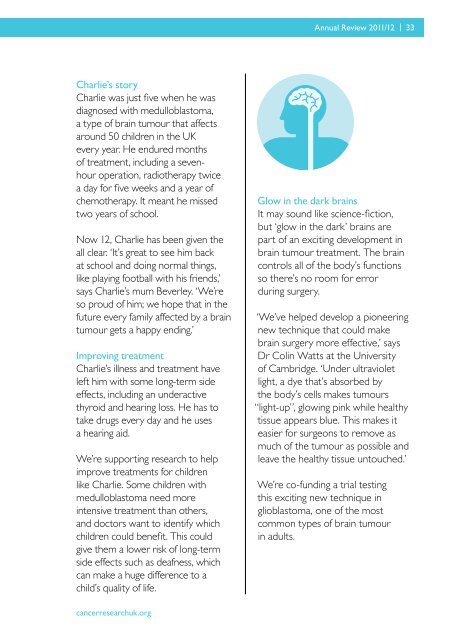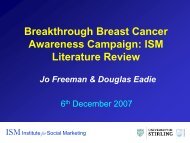Cancer Research UK Annual Review 2011/12
Cancer Research UK Annual Review 2011/12
Cancer Research UK Annual Review 2011/12
Create successful ePaper yourself
Turn your PDF publications into a flip-book with our unique Google optimized e-Paper software.
<strong>Annual</strong> <strong>Review</strong> <strong>2011</strong>/<strong>12</strong> | 33<br />
Charlie’s story<br />
Charlie was just five when he was<br />
diagnosed with medulloblastoma,<br />
a type of brain tumour that affects<br />
around 50 children in the <strong>UK</strong><br />
every year. He endured months<br />
of treatment, including a sevenhour<br />
operation, radiotherapy twice<br />
a day for five weeks and a year of<br />
chemotherapy. It meant he missed<br />
two years of school.<br />
Now <strong>12</strong>, Charlie has been given the<br />
all clear. ‘It’s great to see him back<br />
at school and doing normal things,<br />
like playing football with his friends,’<br />
says Charlie’s mum Beverley. ‘We’re<br />
so proud of him; we hope that in the<br />
future every family affected by a brain<br />
tumour gets a happy ending.’<br />
Improving treatment<br />
Charlie’s illness and treatment have<br />
left him with some long-term side<br />
effects, including an underactive<br />
thyroid and hearing loss. He has to<br />
take drugs every day and he uses<br />
a hearing aid.<br />
We’re supporting research to help<br />
improve treatments for children<br />
like Charlie. Some children with<br />
medulloblastoma need more<br />
intensive treatment than others,<br />
and doctors want to identify which<br />
children could benefit. This could<br />
give them a lower risk of long-term<br />
side effects such as deafness, which<br />
can make a huge difference to a<br />
child’s quality of life.<br />
Glow in the dark brains<br />
It may sound like science-fiction,<br />
but ‘glow in the dark’ brains are<br />
part of an exciting development in<br />
brain tumour treatment. The brain<br />
controls all of the body’s functions<br />
so there’s no room for error<br />
during surgery.<br />
‘We’ve helped develop a pioneering<br />
new technique that could make<br />
brain surgery more effective,’ says<br />
Dr Colin Watts at the University<br />
of Cambridge. ‘Under ultraviolet<br />
light, a dye that’s absorbed by<br />
the body’s cells makes tumours<br />
“light-up”, glowing pink while healthy<br />
tissue appears blue. This makes it<br />
easier for surgeons to remove as<br />
much of the tumour as possible and<br />
leave the healthy tissue untouched.’<br />
We’re co-funding a trial testing<br />
this exciting new technique in<br />
glioblastoma, one of the most<br />
common types of brain tumour<br />
in adults.<br />
cancerresearchuk.org














![[PDF] Cancer Research UK's strategy 2009 - 2014](https://img.yumpu.com/29239422/1/184x260/pdf-cancer-research-uks-strategy-2009-2014.jpg?quality=85)

